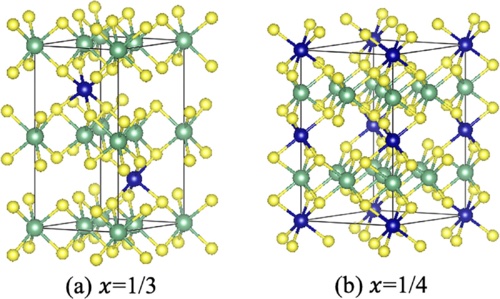
- Spin models and cluster multipole method: Application to kagome magnets
-
Phys. Rev. B 112, 014406(2025)

We present a multiscale computational approach that combines atomistic spin models with the cluster multipole (CMP) method. The CMP method enables a systematic and accurate generation of complex noncollinear magnetic structures using symmetry-adapted representations. The parameters of the spin model are derived from density functional theory using the magnetic force theorem, with the paramagnetic state as a reference. The energy landscape of CMP-generated structures is inspected at the model Hamiltonian level and sets of low-energy magnetic structures are identified for each material candidate. The inclusion of relativistic antisymmetric and anisotropic pair interactions lifts partially the degeneracy among these most stable structures. To demonstrate the applicability and predictive capability of the method, we apply it to the noncollinear Mn3X and collinear Fe3X (X=Ga,Ge, and Sn) kagome compounds. The computational efficiency of the method in identifying low-energy structures among multiple CMP configurations highlights its potential for high-throughput screening of complex magnets with unknown magnetic order.
- Multiferroic Collinear Antiferromagnets with Hidden Altermagnetic Spin Splitting
-
Phys. Rev. Lett. 134, 226703(2025)

Altermagnets exhibit nonrelativistic spin splitting due to the breaking of time-reversal symmetry and have been garnering significant attention as promising materials for spintronic applications. In contrast, conventional antiferromagnets without spin splitting seem to not have any symmetry breaking and have drawn less attention. However, we show that conventional antiferromagnets with a nonzero Q vector bring about nontrivial symmetry breakings. The incompatibility between the Q vector and nonsymmorphic symmetry leads to macroscopic symmetry breaking without lifting spin degeneracy. Moreover, the hidden altermagnetic spin splitting in the electronic structure gives rise to various emergent responses. To examine our prediction, we perform first-principles calculations for MnS2 and investigate its multiferroic properties, such as nonlinear transport and optical activity. Our findings reveal unique properties in conventional antiferromagnets, providing another perspective for designing spintronic materials.
- Nonlinear Hall effect driven by spin-charge-coupled motive force
-
Phys. Rev. B 111, 174416(2025)
Parity-time-reversal symmetric (PT-symmetric) magnets have garnered much attention due to their spin-charge coupled dynamics enriched by parity-symmetry breaking. By real-time simulations, we study how localized spin dynamics can affect the nonlinear Hall effect in PT-symmetric magnets. To identify the leading-order term, we derive analytical expressions for the second-order optical response and classify the contributions by considering their transformation properties under PT symmetry. Notably, our results reveal that sizable contribution is attributed to the mixed dipole effect, which is analogous to the Berry curvature dipole term.
- Topological Hall Effect of Skyrmions from first Principles
-
Phys. Rev. X 15, 011054(2025)

We formulate a first-principles approach for calculating the topological Hall effect (THE) in magnets with noncollinear nanoscale spin textures. We employ a modeling method to determine the effective magnetic field induced by the spin texture, thereby circumventing the computational challenges associated with superlattice calculations. Based on these results, we construct a Wannier tight-binding Hamiltonian to characterize the electronic states and calculate the Hall conductivity. Applying this approach to the skyrmion material Gd2PdSi3 shows good agreement with experimental data. Our analysis in momentum space further reveals that the dominant contribution to the THE arises from the crossing points between the folded bands along high-symmetry lines in the Brillouin zone. This work advances numerical techniques for simulating a general magnetic system, exemplified by but not restricted to skyrmion lattice, and its result offering insights into the complex interplay between spin textures and electronic transport.
- Ab initio study on magnetism suppression, anharmonicity, rattling mode, and superconductivity in Sc6M Te2 (M=Fe,Co,Ni)
-
Phys. Rev. B 110, 104505 (2024)

We perform a systematic ab initio study on phonon-mediated superconductivity in the transition-metal-based superconductors Sc6M Te2 (M=Fe,Co,Ni). Firstly, our charge analysis reveals significant electron transfer from Sc to because of the substantial difference in the electronegativity, filling the 3 d orbitals of M and suppressing magnetic instability. Secondly, we show that Sc6 FeTe2 exhibits strong lattice anharmonicity. Moreover, for M=Fe and Co, we find low-frequency soft phonon bands of M, which can be interpreted as rattling phonons in the framework formed by Sc. While not observed in the case of M=Ni, the rattling phonons give rise to a prominent peak or plateau in the Eliashberg spectral function and enhance the pairing instability. By reproducing the experimental trend of superconducting transition temperatures, our study underscores the potential of designing phonon-mediated superconductors by strategically combining nonsuperconducting and magnetic transition-metal elements.
- Continuous crossover between insulating ferroelectrics and polar metals: Ab initio calculation of structural phase transitions of LiBO3 (B=Ta, W, Re, Os)
-
Phys. Rev. B 110, 094102 (2024)

Inspired by the recent discovery of a new polar metal LiReO3 by K. Murayama et al, we calculate the temperature (T)-dependent crystal structures of LiBO3 with B=Ta, W, Re, Os, using the self-consistent phonon (SCPH) theory. We have reproduced the experimentally observed polar-nonpolar structural phase transitions and the transition temperatures (Tc) of LiTaO3, LiReO3, and LiOsO3. From the calculation, we predict that LiWO3 is a polar metal, which is yet to be tested experimentally. Upon doping electrons to the insulating LiTaO3, the predicted Tc is quickly suppressed and approaches those of the polar metals. Thus, there is a continuous crossover between ferroelectric insulators and polar metals if we dope electrons to the ferroelectric insulators. Investigating the detailed material dependence of the interatomic force constants (IFCs), we explicitly show that the suppression of Tc in polar metals can be ascribed to the screening of the long-range Li-O interaction, which is caused by the presence of the itinerant electrons. The quantitative finite-temperature calculations do not show signs of unscreened long-range interactions by the weak electron-phonon coupling or enhancement of polar instabilities by carrier doping, as expected in some previous works.
- First-principles study of the tunnel magnetoresistance effect with Cr-doped RuO2 electrode
-
Phys. Rev. B 110, 064433 (2024)
We investigate the functionality of the Cr-doped RuO2 as an electrode of the magnetic tunnel junction (MTJ), motivated by a recent experiment showing that Cr doping into rutile-type RuO2 is an effective tool to easily control its antiferromagnetic order and the resultant magnetotransport phenomena. We perform first-principles calculation of the tunnel magnetoresistance (TMR) effect in the MTJ based on the Cr-doped RuO2 electrodes. We find that a finite TMR effect appears in the MTJ originating from the momentum-dependent spin splitting in the electrodes, which suggests that RuO2 with Cr doping will function effectively as the electrode of the MTJ. We also show that this TMR effect can be qualitatively captured by the local density of states inside the tunnel barrier.
- Effect of collective spin excitations on electronic transport in topological spin textures
-
Phys. Rev. B 110, 014425 (2024)

We develop an efficient real-time simulation method for the spin-charge coupled system in the velocity gauge. This method enables us to compute the real-time simulation for the two-dimensional system with a complex spin texture. We focus on the effect of the collective excitation of the localized spins on the electronic transport properties of the nontrivial topological state in real space. To investigate this effect, we calculate the linear optical conductivity by calculating the real-time evolution of the Kondo lattice model on the triangular lattice, which hosts an all-in/all-out (triple-Q) magnetic structure. In the linear conductivity spectra, we observe multiple peaks below the band gap regime, attributed to the resonant contributions of collective modes similar to the skyrmionic system, alongside broadband modifications resulting from off-resonant spin dynamics. This result shows that the collective excitation, similar to the skyrmionic system, influences the optical response of the electron systems based on symmetry analysis. We elucidate the interference between the contributions from the different spin excitations to the optical conductivity in the multiple-spin texture, pointing out the mode-dependent electrical activity. We show the complex interplay between the complex spin texture and the itinerant electrons in the two-dimensional spin-charge coupled system.
- Universal chemical formula dependence of ab initio low-energy effective Hamiltonian in single-layer carrier-doped cuprate superconductors: Study using a hierarchical dependence extraction algorithm
-
Phys. Rev. B 110, 014502 (2024)

We explore the possibility to control the superconducting transition temperature at optimal hole doping Toptc in cuprates by tuning the chemical formula (CF). Toptc can be theoretically predicted from the parameters of the ab initio low-energy effective Hamiltonian with one antibonding (AB) Cu 3dx2-y2/O 2pσ orbital per Cu atom in the CuO2 plane, notably the nearest-neighbor hopping amplitude |t1| and the ratio u=U/|t1|, where U is the onsite effective Coulomb repulsion. However, the CF dependence of |t1| and u is a highly nontrivial question. In this paper, we propose the universal dependence of |t1| and u on the CF and structural features in hole doped cuprates with a single CuO2 layer sandwiched between block layers. To do so, we perform extensive ab initio calculations of |t1| and u and analyze the results by employing a machine-learning method called hierarchical dependence extraction (HDE). The main results are (a) |t1| has a main-order dependence on the radii RX and RA of the apical anion X and cation A in the block layer. (|t1| increases when RX or RA decreases.) (b) u has a main-order dependence on the ionic charge ZX of X and the hole doping δ of the AB orbital. (u decreases when |ZX| increases or δ increases.) We elucidate and discuss the microscopic mechanism of items (a) and (b). We demonstrate the predictive power of the HDE by showing the consistency between items (a) and (b) and results from previous works. The present results provide a basis for optimizing superconducting properties in cuprates and possibly akin materials. Also, the HDE method offers a general platform to identify dependencies between physical quantities.
- Symmetry analysis with spin crystallographic groups: Disentangling effects free of spin-orbit coupling in emergent electromagnetism
-
Phys. Rev. B 109, 094438 (2024) (Editors' suggestion)
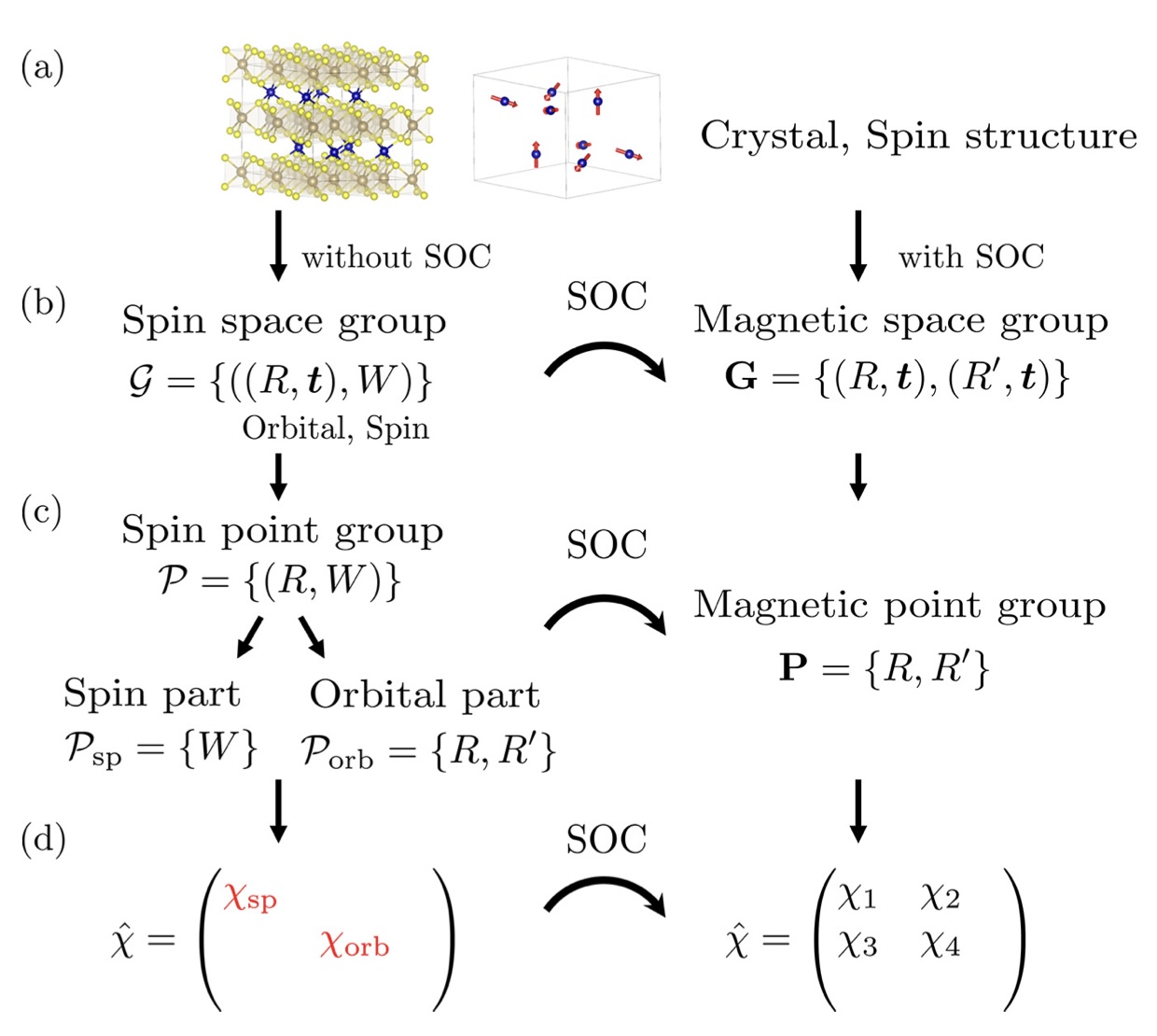
Recent studies identified spin-order-driven phenomena such as spin-charge interconversion without relying on the relativistic spin-orbit interaction. Those physical properties can be prominent in systems containing light magnetic atoms due to sizable exchange splitting and may pave the way for realization of giant responses correlated with the spin degree of freedom. In this paper, we present a systematic symmetry analysis based on the spin crystallographic groups and identify the physical property of a vast number of magnetic materials up to 1500 in total. By decoupling the spin and orbital degrees of freedom, our analysis enables us to take a closer look into the relation between the dimensionality of spin structures and the resultant physical properties and to identify the spin and orbital contributions separately. In stark contrast to the established analysis with magnetic space groups, the spin crystallographic group manifests richer symmetry including spin-translation symmetry and leads to emergent responses. For representative examples, we discuss the geometrical nature of the anomalous Hall effect and magnetoelectric effect and classify the spin Hall effect arising from the nonrelativistic spin-charge coupling. Using the power of computational analysis, we apply our symmetry analysis to a wide range of magnets, encompassing complex magnets such as those with noncoplanar spin structures as well as collinear and coplanar magnets. We identify emergent multipoles relevant to physical responses and argue that our method provides a systematic tool for exploring sizable electromagnetic responses driven by spin order.
- High-throughput calculations of antiferromagnets hosting anomalous transport phenomena
-
Phys. Rev. B 109, 094435 (2024)
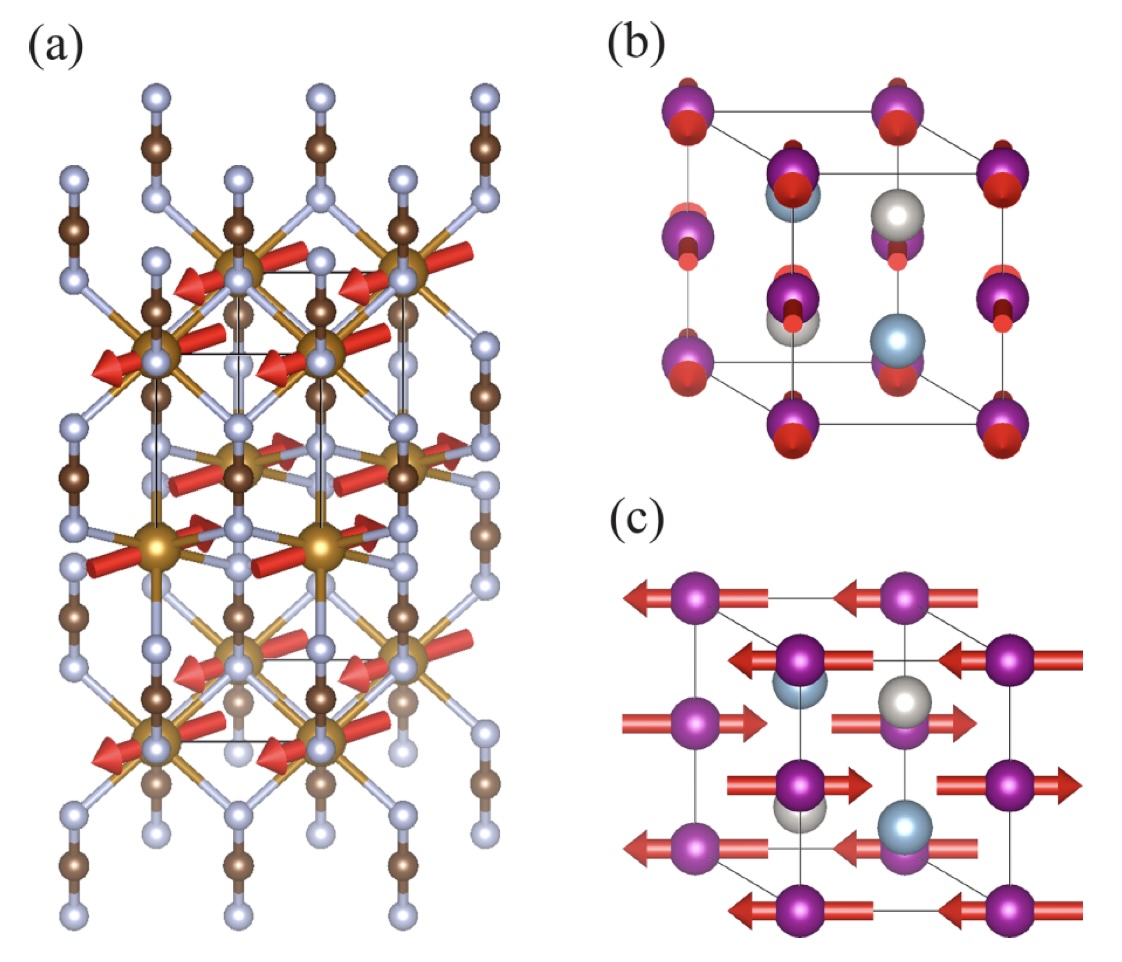
We develop a high-throughput computational scheme based on cluster multipole theory to identify new functional antiferromagnets (AFMs). This approach is applied to 228 magnetic compounds listed in the AtomWork-Adv database, known for their elevated Neel temperatures. We conduct systematic investigations of both stable and metastable magnetic configurations of these materials. Our findings reveal that 34 of these compounds exhibit AFM structures with zero propagation vectors and magnetic symmetries identical to conventional ferromagnets, rendering them potentially invaluable for spintronics applications. By cross-referencing our predictions with the existing MAGNDATA database and published literature, we verify the reliability of our findings for 26 out of 28 compounds with partially or fully elucidated magnetic structures in the experiments. These results not only affirm the reliability of our scheme but also point to its potential for broader applicability in the ongoing quest for the discovery of functional magnets.
- Development of an ab initio method for exciton condensation and its application to TiSe2
-
Phys. Rev. Research 5, 043183 (2023)

Exciton condensation is a phenomenon that indicates the spontaneous formation of electron-hole pairs, which can lead to a phase transition from a semimetal to an excitonic insulator by opening a gap at the Fermi surface. Although the idea of an excitonic insulator has been proposed for several decades, current theoretical approaches can only provide qualitative descriptions, and a quantitative predictive tool is still lacking. To shed light on this issue, we developed an ab initio method based on finite-temperature density functional theory and many-body perturbation theory to calculate the critical behavior of exciton condensation. Utilizing our methodology on monolayer TiSe2, we identify a phase transition involving lattice distortion and nontrivial electron-hole correlation at a temperature exceeding the critical temperature of phonon softening. By breaking down the components within the gap equation, we demonstrate that exciton condensation, mediated by electron-phonon interaction, is the underlying cause of the charge-density-wave state observed in this compound. Overall, the methodology introduced in this work is general and sets the stage for searching for potential excitonic insulators in natural material systems.
- Natural orbital impurity solver for real-frequency properties at finite temperature
-
Phys. Rev. B 108, 195124 (2023)
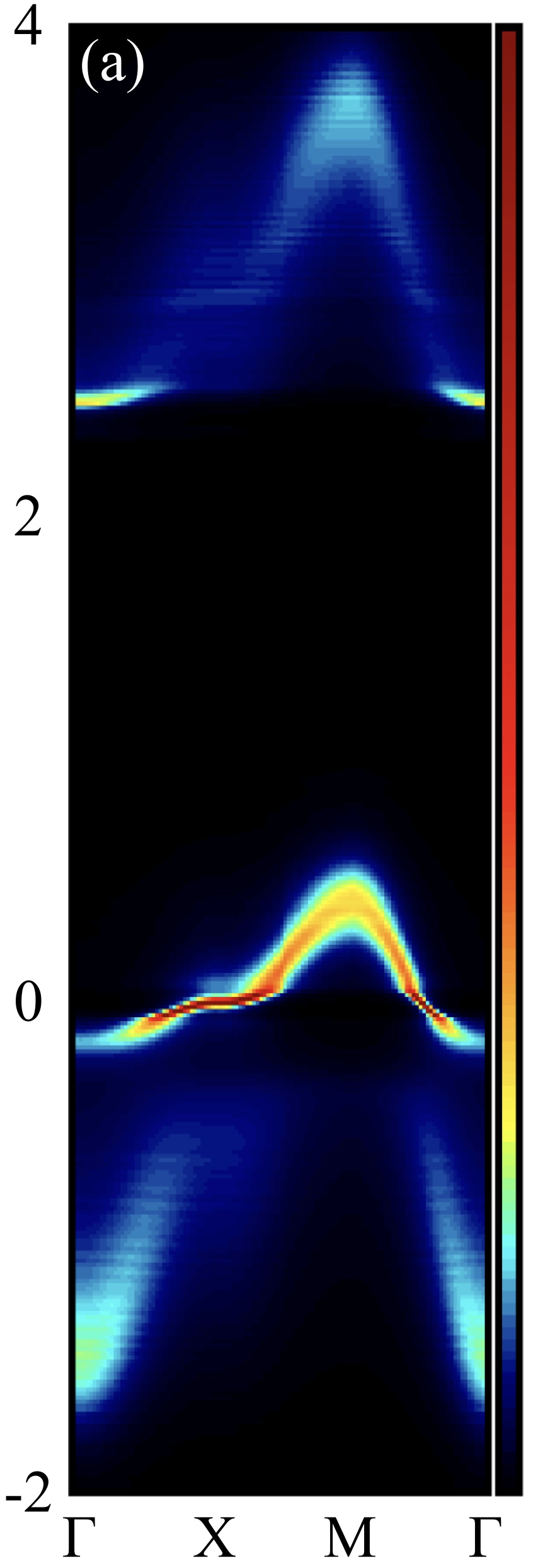
We extend the natural orbital impurity solver [Y. Lu, M. Hoeppner, O. Gunnarsson, and M. W. Haverkort, Phys. Rev. B 90, 085102 (2014)] to finite temperatures and apply it to calculate spectral and transport properties of correlated electrons within the dynamical mean-field theory. First, we benchmark our method against the exact diagonalization result for small clusters, finding that the natural orbital scheme works well not only for zero temperature but for low finite temperatures. The method yields smooth and sufficiently accurate spectra, which agree well with the results of the numerical renormalization group. Using the smooth spectra, we calculate the electric conductivity and Seebeck coefficient for the two-dimensional Hubbard model at low temperatures which are within the scope of many experiments and practical applications. These results demonstrate the usefulness of the natural orbital framework for obtaining the real frequency information of correlated electron systems.
- Suppression of heating by multicolor driving protocols in Floquet-engineered strongly correlated systems
-
Phys. Rev. B 108, 035151 (2023)
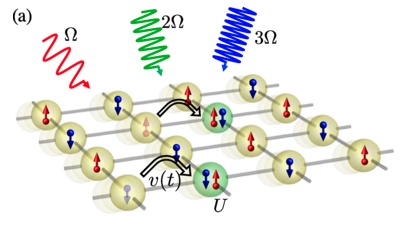
Heating effects in Floquet-engineered systems are detrimental to the control of physical properties. In this paper, we show that the heating of periodically driven strongly correlated systems can be suppressed by multicolor driving, i.e., by applying auxiliary excitations which interfere with the absorption processes from the main drive. We focus on the Mott insulating single-band Hubbard model and study the effects of multicolor driving with nonequilibrium dynamical mean-field theory. The main excitation is a periodic electric field with frequency &Omega smaller than the Mott gap, while for the auxiliary excitations, we consider additional electric fields and/or hopping modulations with a higher harmonic of &Omega. To suppress the three-photon absorption of the main excitation, which is a parity-odd process, we consider auxiliary electric-field excitations and a combination of electric-field excitations and hopping modulations. On the other hand, to suppress the two-photon absorption, which is a parity-even process, we consider hopping modulations. The conditions for an efficient suppression of heating are well captured by the Floquet effective Hamiltonian derived with the high-frequency expansion in a rotating frame. As an application, we focus on the exchange couplings of the spins (pseudospins) in the repulsive (attractive) model and demonstrate that the suppression of heating allows us to realize and clearly observe a significant Floquet-induced change of the low energy physics.
- Local density of states as a probe for tunneling magnetoresistance effect: Application to ferrimagnetic tunnel junctions
-
Phys. Rev. B 107, 214442 (2023)
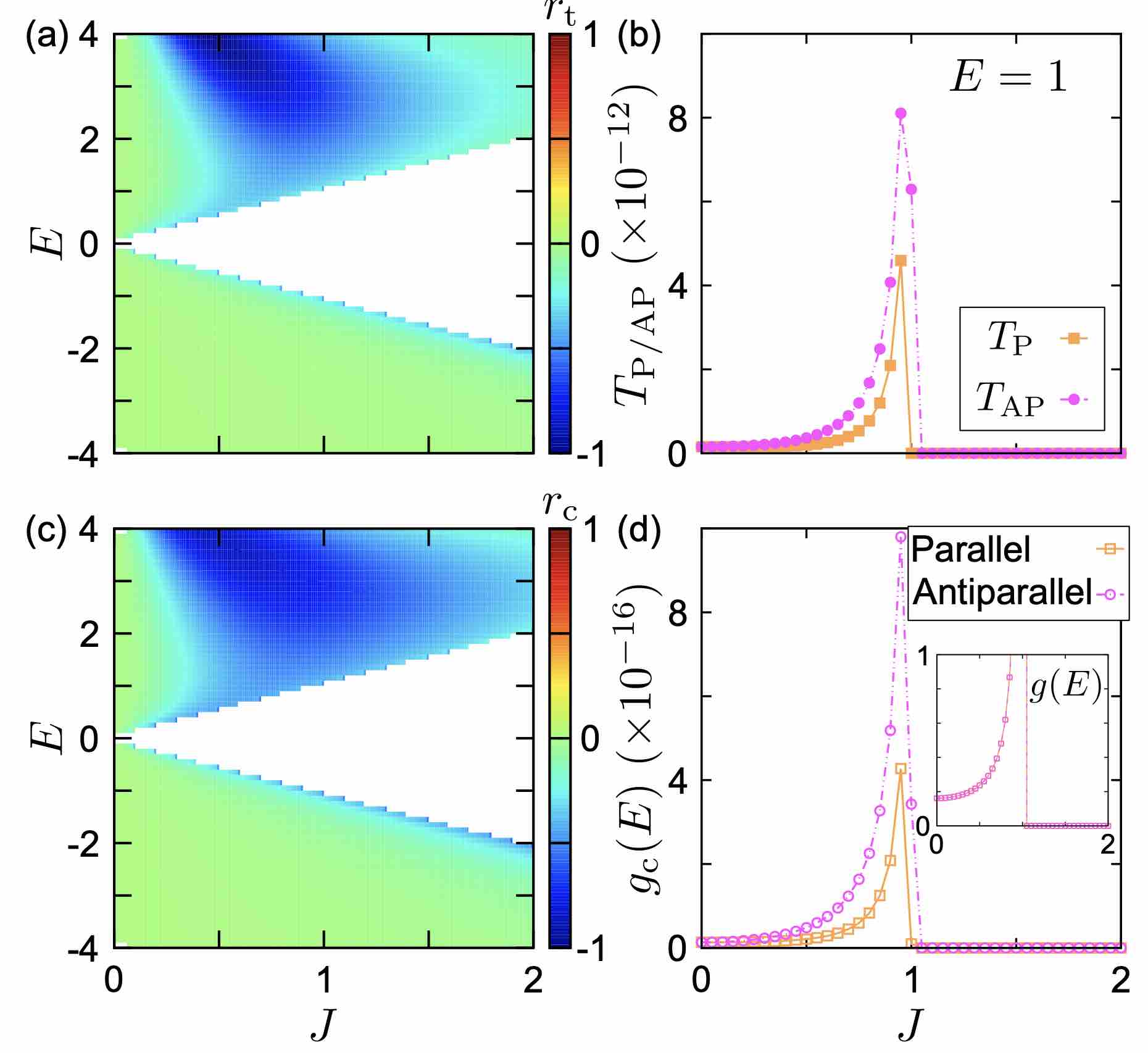
We investigate the tunneling magnetoresistance (TMR) effect using the lattice models which describe the magnetic tunnel junctions (MTJ). First, taking a conventional ferromagnetic MTJ as an example, we show that the product of the local density of states (LDOS) at the center of the barrier traces the TMR effect qualitatively. The LDOS inside the barrier has the information on the electrodes and the electron tunneling through the barrier, which enables us to easily evaluate the tunneling conductance more precisely than the conventional Julliere's picture. We then apply this method to the MTJs with collinear ferrimagnets including antiferromagnets. The TMR effect in the ferrimagnetic MTJs changes depending on the interfacial magnetic structures originating from the sublattice structure, which can also be captured by the LDOS. Our findings will reduce the computational cost for the qualitative evaluation of the TMR effect and be useful for a broader search for the materials which work as the TMR devices showing high performance.
- Magnetic interactions in intercalated transition metal dichalcogenides: A study based on ab initio model construction
-
Phys. Rev. B 107, 184429 (2023)
Transition metal dichalcogenides (TMDs) are known to have a wide variety of magnetic structures by hosting other transition metal atoms in the van der Waals gaps. To understand the chemical trend of the magnetic properties of the intercalated TMDs, we perform a systematic first-principles study for 48 compounds with different hosts, guests, and composition ratios. Starting with calculations based on spin density functional theory, we derive classical spin models by applying the local force method to the ab initio Wannier-based tight-binding model. We show that the calculated exchange couplings are overall consistent with the experiments, and the chemical trend can be understood in terms of the occupation of the 3d orbital in the intercalated transition metal. The present results give us a useful guiding principle to predict the magnetic structure of compounds that are yet to be synthesized.
- Dynamical mean-field theory for the Hubbard-Holstein model on a quantum device
-
Phys. Rev. B 107, 165155 (2023) (Editors' suggestion)
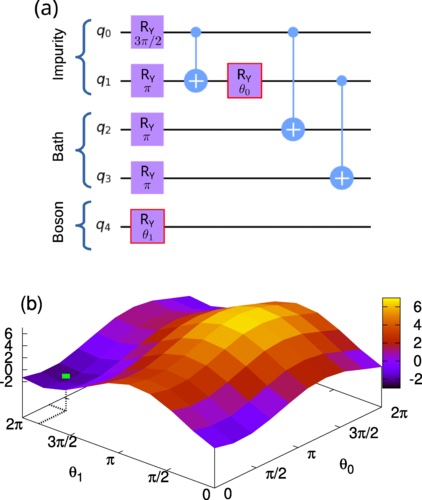
Recent developments in quantum hardware and quantum algorithms have made it possible to utilize the capabilities of current noisy intermediate-scale quantum devices for addressing problems in quantum chemistry and condensed-matter physics. Here we report a demonstration of solving the dynamical mean-field theory (DMFT) impurity problem for the Hubbard-Holstein model on the IBM Quantum Processor Kawasaki, including self-consistency of the DMFT equations. This opens up the possibility to investigate strongly correlated electron systems coupled to bosonic degrees of freedom and impurity problems with frequency-dependent interactions. The problem involves both fermionic and bosonic degrees of freedom to be encoded on the quantum device, which we solve using a recently proposed Krylov variational quantum algorithm to obtain the impurity Green's function. We find the resulting spectral function to be in good agreement with the exact result, exhibiting both correlation and plasmonic satellites and significantly surpassing the accuracy of standard Trotter-expansion approaches. Our results provide an essential building block to study electronic correlations and plasmonic excitations on future quantum computers with modern ab initio techniques.
- Optimizing Superconductivity: From Cuprates via Nickelates to Palladates
-
Phys. Rev. Lett. 130 166002 (2023)(Editors' suggestion), featured in Physics
Motivated by cuprate and nickelate superconductors, we perform a comprehensive study of the superconducting instability in the single-band Hubbard model. We calculate the spectrum and superconducting transition temperature Tc as a function of filling and Coulomb interaction for a range of hopping parameters, using the dynamical vertex approximation. We find the sweet spot for high Tc to be at intermediate coupling, moderate Fermi surface warping, and low hole doping. Combining these results with first principles calculations, neither nickelates nor cuprates are close to this optimum within the single-band description. Instead, we identify some palladates, notably RbSr2PdO3 and A'2PdO2Cl2 (A'=Ba0.5La0.5), to be virtually optimal, while others, such as NdPdO2, are too weakly correlated.
















